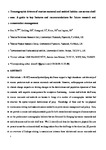Oceanographic drivers of marine mammal and seabird habitat-use across shelf-seas: A guide to key features and recommendations for future research and conservation management
| dc.contributor.author | Cox, SL | |
| dc.contributor.author | Embling, Clare | |
| dc.contributor.author | Hosegood, Philip | |
| dc.contributor.author | Votier, SC | |
| dc.contributor.author | Ingram, Simon | |
| dc.date.accessioned | 2018-06-23T12:15:55Z | |
| dc.date.issued | 2018-11-15 | |
| dc.identifier.issn | 0272-7714 | |
| dc.identifier.issn | 1096-0015 | |
| dc.identifier.uri | http://hdl.handle.net/10026.1/11734 | |
| dc.description.abstract |
Mid-latitude (∼30-60°) seasonally stratifying shelf-seas support a high abundance and diversity of marine predators such as marine mammals and seabirds. However, anthropogenic activities and climate change impacts are driving changes in the distributions and population dynamics of these animals, with negative consequences for ecosystem functioning. Across mid-latitude shelf-seas marine mammals and seabirds are known to forage across a number of oceanographic habitats that structure the spatio-temporal distributions of prey fields. Knowledge of these and the bio-physical mechanisms driving such associations are needed to improve marine management and policy. Here, we provide a concise and easily accessible guide for both researchers and managers of marine systems on the predominant oceanographic habitats that are favoured for foraging by marine mammals and seabirds across mid-latitude shelf-seas. We (1) identify and describe key discrete physical features present across the continental shelf, working inshore from the shelf-edge to the shore line, (2) provide an overview of findings relating to associations between these habitats and marine mammals and seabirds, (3) identify areas for future research and (4) discuss the relevance of such information to conservation management. We show that oceanographic features preferentially foraged at by marine mammals and seabirds include shelf-edge fronts, upwelling and tidal-mixing fronts, offshore banks and internal waves, regions of stratification, and topographically complex coastal areas subject to strong tidal flow. Whilst associations were variable across taxa and through space and time, in the majority of cases interactions between bathymetry and tidal currents appear to play a dominant role, alongside patterns in seasonal stratification and shelf-edge upwelling. We suggest that the ecological significance of these bio-physical structures stems from a capacity to alter the densities, distributions (both horizontally and vertically) and/or behaviours of prey in a persistent and/or predictable manner that increases accessibility for predators, and likely enhances foraging efficiency. Future conservation management should aim to preserve and protect these habitats. This will require adaptive and holistic strategies that are specifically tailored to the characteristics of an oceanographic feature, and where necessary, evolve through space and time in response to spatio-temporal variability. Improved monitoring of animal movements and bio-physical conditions across shelf-seas would aid in this. Areas for future research include multi-disciplinary/trophic studies of the mechanisms linking bio-physical processes, prey and marine mammals and seabirds (which may elucidate the importance of lesser studied features such as bottom fronts and Langmuir circulation cells), alongside a better understanding of how predators perceive their environment and develop foraging strategies during immature/juvenile stages. Estimates of the importance of oceanographic habitat features at a population level should also be obtained. Such information is vital to ensuring the future health of these complex ecosystems, and can be used to assess how anthropogenic activities and future environmental changes will impact the functioning and spatio-temporal dynamics of these bio-physical features and their use by marine predators. | |
| dc.format.extent | 294-310 | |
| dc.language | en | |
| dc.language.iso | en | |
| dc.publisher | Elsevier | |
| dc.subject | Habitat selection | |
| dc.subject | Foraging ecology | |
| dc.subject | Bio-physical coupling | |
| dc.subject | Conservation management | |
| dc.subject | Marine mammals | |
| dc.subject | Oceanography | |
| dc.subject | Seabirds | |
| dc.title | Oceanographic drivers of marine mammal and seabird habitat-use across shelf-seas: A guide to key features and recommendations for future research and conservation management | |
| dc.type | journal-article | |
| dc.type | Review | |
| dc.type | Journal | |
| plymouth.author-url | https://www.webofscience.com/api/gateway?GWVersion=2&SrcApp=PARTNER_APP&SrcAuth=LinksAMR&KeyUT=WOS:000446286100029&DestLinkType=FullRecord&DestApp=ALL_WOS&UsrCustomerID=11bb513d99f797142bcfeffcc58ea008 | |
| plymouth.volume | 212 | |
| plymouth.publication-status | Published | |
| plymouth.journal | Estuarine, Coastal and Shelf Science | |
| dc.identifier.doi | 10.1016/j.ecss.2018.06.022 | |
| plymouth.organisational-group | /Plymouth | |
| plymouth.organisational-group | /Plymouth/Faculty of Science and Engineering | |
| plymouth.organisational-group | /Plymouth/Faculty of Science and Engineering/School of Biological and Marine Sciences | |
| plymouth.organisational-group | /Plymouth/PRIMaRE Publications | |
| plymouth.organisational-group | /Plymouth/REF 2021 Researchers by UoA | |
| plymouth.organisational-group | /Plymouth/REF 2021 Researchers by UoA/UoA07 Earth Systems and Environmental Sciences | |
| plymouth.organisational-group | /Plymouth/Research Groups | |
| plymouth.organisational-group | /Plymouth/Research Groups/Marine Institute | |
| plymouth.organisational-group | /Plymouth/Users by role | |
| plymouth.organisational-group | /Plymouth/Users by role/Academics | |
| plymouth.organisational-group | /Plymouth/Users by role/Researchers in ResearchFish submission | |
| dcterms.dateAccepted | 2018-06-23 | |
| dc.rights.embargodate | 2019-6-28 | |
| dc.identifier.eissn | 1096-0015 | |
| dc.rights.embargoperiod | No embargo | |
| rioxxterms.versionofrecord | 10.1016/j.ecss.2018.06.022 | |
| rioxxterms.licenseref.uri | http://www.rioxx.net/licenses/all-rights-reserved | |
| rioxxterms.licenseref.startdate | 2018-11-15 | |
| rioxxterms.type | Journal Article/Review |


